Doris Salcedo’s retrospective has traveled from the Museum of Contemporary Art in Chicago to the Solomon R. Guggenheim Museum in New York, where it occupies all five levels of the museum’s tower. This exhibition confronts issues of civil war and unrest, gang violence, displacement, and political upheaval across the world and throughout the twentieth century, yet these subjects could not be more relevant to the contemporary American consciousness as we struggle with these same issues today. Salcedo uses ordinary objects from our daily lives to elicit a sense of displacement and loss related to the suffering of political violence victims. Salcedo comes from Colombia, the country with the longest-running civil turmoil in the Western Hemisphere.[i] While some works relate to a specific tragic event and others to the general feeling of loss, the artist undoubtedly connects with the victims from her home country and around the world who deserve to be considered and remembered. In a January 2015 interview, Salcedo claimed that in our modern society, “we have lost our ability to mourn.”[ii] She addresses this problem through the use of familiar domestic objects, curing our insensitivity by allowing us to connect personally with the victims and to witness violence from their perspective.
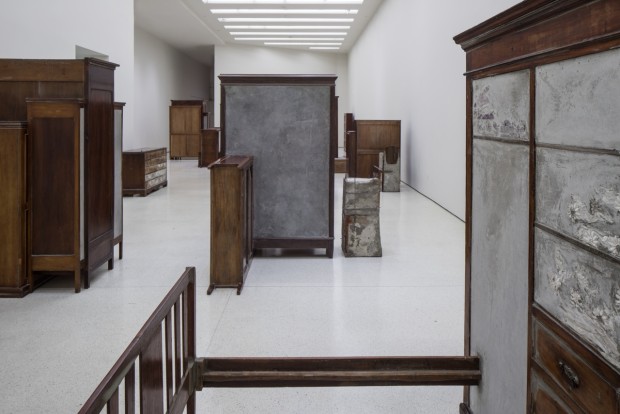
Photo: David Heald © Solomon R. Guggenheim Foundation
The strongest and most poignant work in this exhibition is Atrabiliarios, an installation housed in the back gallery of tower floor two. Boxes containing shoes—either singly or in pairs—are inset into the walls at eye level and covered with a yellowing opaque animal fiber that is stitched into the wall with thick, black filament. An eerie feeling emanates throughout the space, invoking images of the discarded possessions of Holocaust victims and prompting the viewer to connect the objects with the departed. Before arriving in this room, one passes through a gallery containing Plegaria Muda, Salcedo’s garden of “silent prayer” in remembrance of those who have been killed by gang violence in the United States. A counterintuitive arrangement of coffin-like sculptures creates a labyrinth through which one may choose to meander. The structures are formed by pairs of tables, one upright and the other turned upside down on top of it, with a large layer of compacted dirt in between them. Upon closer examination, one may notice blades of hopeful green grass sprouting from the wooden tables like delicate lifelines. An intricate irrigation system, hidden in the table legs and supervised daily by the Guggenheim staff, keeps the grass alive throughout the exhibition.
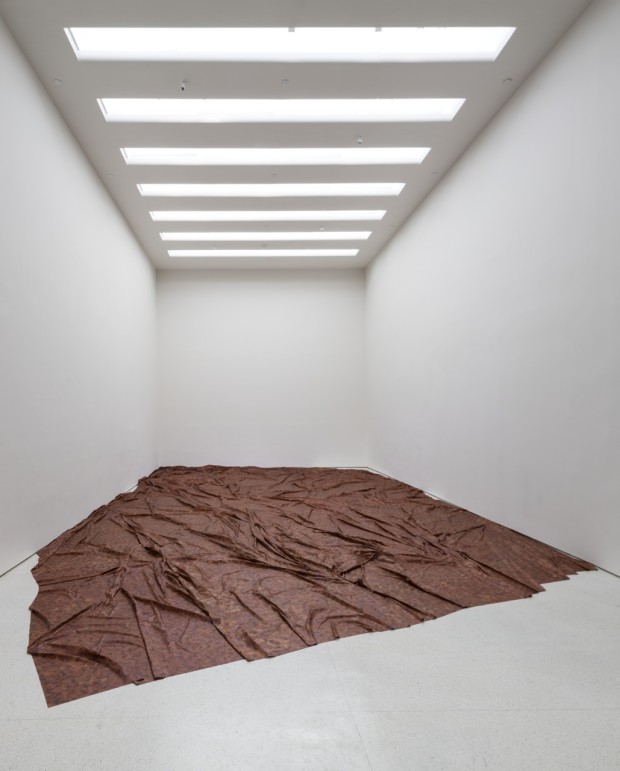
Photo: David Heald¬ © Solomon R. Guggenheim Foundation
Level four of the Guggenheim tower contains three sets of emotionally complex, yet visually austere works. Untitled consists of several steel bed frames covered in cotton and animal fiber alongside a row of stacked white dress shirts impaled through the upper right chest by steel bars. Encountering strong feelings of empathy, the viewer must come to terms with the countless, anonymous lives lost and the remnants of an all-too brief existence left behind. This soberly monochromatic installation was intentionally sectioned off from the next room on level four, which contains the much more eclectic work La Casa Viuda. Encompassing five different parts, four of which are united for this exhibition,[iii] La Casa Viuda lacks the emotional presence of other works on level four, yet still inspires close examination and consideration. The pieces are assemblages of wood, steel, plaster, furniture fragments, clothing, bone and other materials. The seemingly random placement of the sculptures perhaps mirrors the inherent randomness of disaster and tragedy. Anyone who has lived through a hurricane, earthquake, or flood could view these sculptures and be reminded of their ruined possessions left behind in the wake of catastrophe.
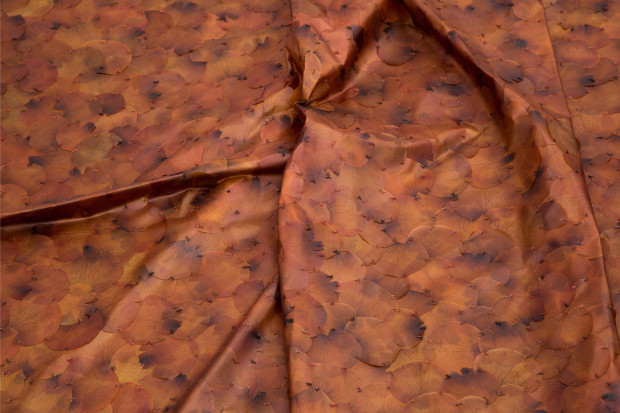
A Flor de Piel (detail), 2014
Rose petals and thread, 1333.5 x 650 cm
D. Daskalopoulos Collection
Installation view: Doris Salcedo, Museum of Contemporary Art Chicago, February 21–May 24, 2015
Photo: Patrizia Tocci
The final room on level four contains Salcedo’s most recent work, Disremembered, which was completed in 2014. From a distance this piece appears to consist of several women’s shawls hanging from nails on the gallery wall; up close, however, a revelation occurs when the viewer realizes that they are made entirely of sharp steel sewing needles. Quiet and yet piercing, Disremembered invokes the metaphorical shawl of grief worn by women who are affected by violence. When crafting Disremembered, Salcedo claims to have been specifically inspired by victims of gun violence in Chicago, the city that gave birth to this retrospective and, much like its current host of New York, has been all too often wrought with violence and corruption.
Salcedo creates another alternative kind of fabric in her piece A Flor de Piel installed in the Guggenheim’s tower level seven. Colloquially translated as “Wearing Your Heart on Your Sleeve,”[iv] A Flor de Piel is a blanket of preserved rose petals stitched together by the artist that stretches forty feet across the gallery floor. Salcedo embarked on this labor-intensive project in remembrance of a Colombian nurse who was tortured to death. Treated with a mixture of glycerine and collagen, the rose petals defy aging for the purpose of keeping the nurse’s memory alive.[v] The ephemerality of the piece mirrors that of human flesh, and the reddish tone that engulfs the gallery reminds the viewer of blood shed amidst the tragedies of war and brutality.
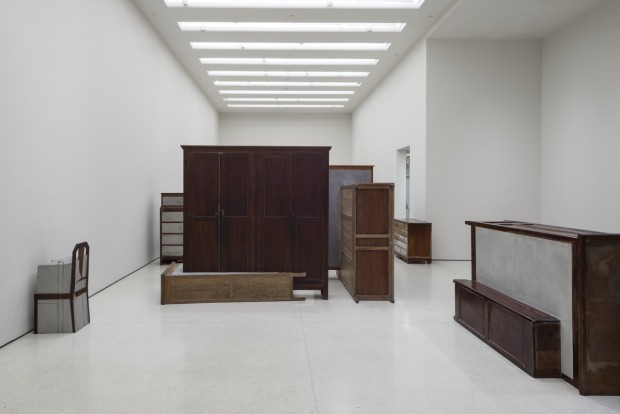
Photo: David Heald¬ © Solomon R. Guggenheim Foundation
The front gallery of tower level seven contains three separate sculptures from the Unland series, all assembled from the halves of mismatched tables and meticulously covered in human hair and raw silk. For the title of this series, Salcedo was inspired by the Jewish Romanian poet Paul Celan whose parents were victims of a Nazi concentration camp and who, himself, was a prisoner of a labor camp in Romania during World War Two. The term “Unland” is Salcedo’s description of refugee life: namely, the feeling of displacement and, per chance, the glimmer of hope that exists behind the stitching back together of two broken halves of yourself.
The documentary Doris Salcedo’s Public Works, which is screened daily in the Guggenheim’s New Media Theater and entails twenty-five minutes of the self-explanatory title, provides a mere glimpse into the artist’s widespread public influence and oeuvre. While the challenge of bringing site-specific public works into a museum setting is not fully overcome through this documentary, the Guggenheim has effectively offered visitors an opportunity to experience these works inside the museum and in the context of the exhibition.
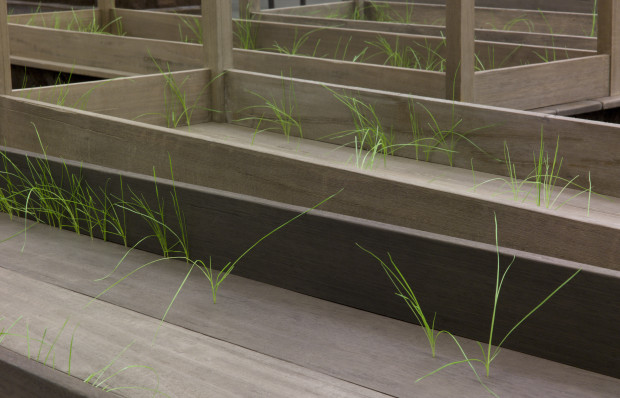
Plegaria Muda, 2008–10
Wood, concrete, earth, and grass
One hundred and sixty-six parts, each: 64-5/8 x 84-1/2 x 24 in. (164 x 214 x 61 cm)
Overall dimensions variable
Installation view, MUAC, Mexico City, 2011
Inhotim Collection, Brazil
Photo: Jason Mandella
Reproduced courtesy of White Cube
Doris Salcedo has brought the affecting human experience back to the museum. The drama in these installations cannot be ignored. It compels the viewer to feel, no matter how concerted our efforts to resist doing so. With this exhibition, we finally encounter an artist who evocatively portrays important political and social issues through the vehicle of contemporary art. As an artist, Salcedo boldly assumes social responsibility in a time when the art market may be more inclined to the acceptance of aesthetically concerned work. She reminds us of the emotional catharsis and political engagement contemporary art is capable of. Salcedo challenges viewers rather than entertains them, and most importantly, she calls on us to remember the forgotten.
[i] Julie Rorigues Widholm, “Presenting Absence: The Work of Doris Salcedo,” in Doris Salcedo (Chicago: University of Chicago Press, 2015), 18.
[ii] Finkel, Jori, “Doris Salcedo, Whose Art Honors Lives Lost, Gets a Retrospective in Chicago,” New York Times, last modified 11 February 2015, accessed 24 September 2015, http://www.nytimes.com/2015/02/15/arts/design/doris-salcedo-whose-art-honors-lives-lost-gets-a-retrospective-in-chicago.html?_r=0.
[iii] Madeleine Grynsztejn, “Introduction” in Doris Salcedo (Chicago: University of Chicago Press, 2015), 13.
[iv] Finkel, “Doris Salcedo, Whose Art Honors Lives Lost.”
[v] “Doris Salcedo, The Making of A Flor de Piel,” White Cube, accessed 30 September 2015, http://whitecube.com/channel/in_the_studio/doris_salcedo_in_the_studio_2012/.

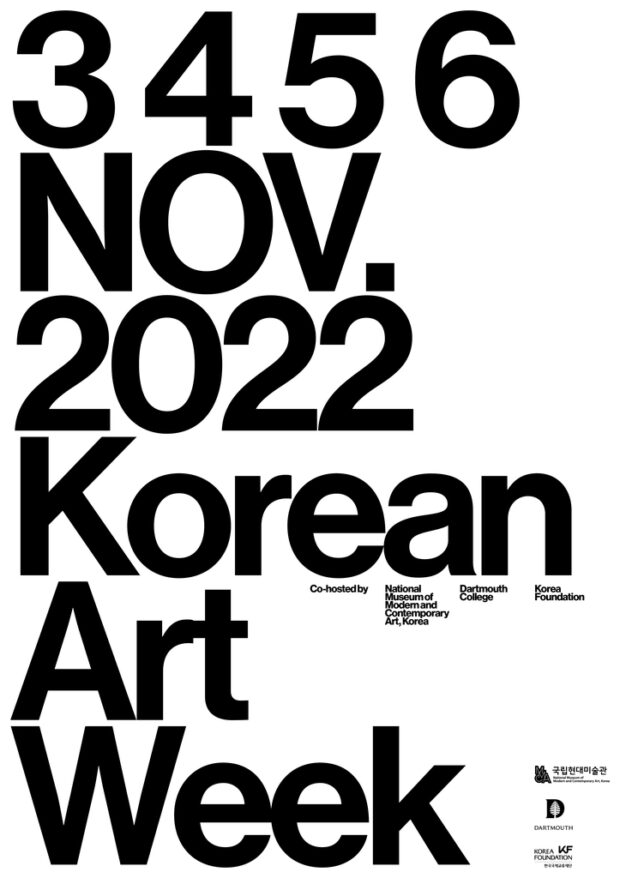

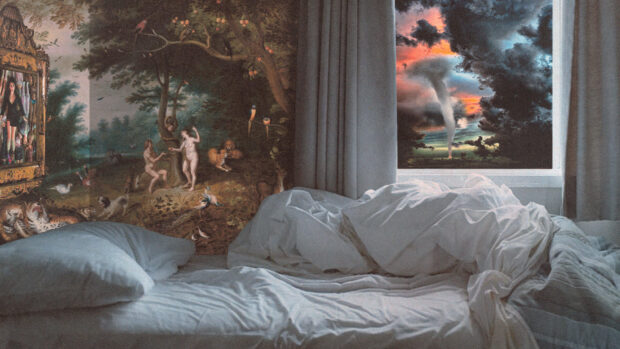
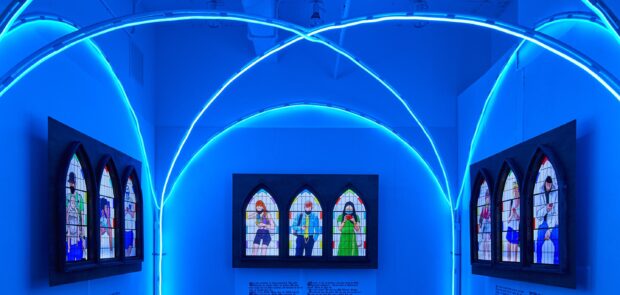
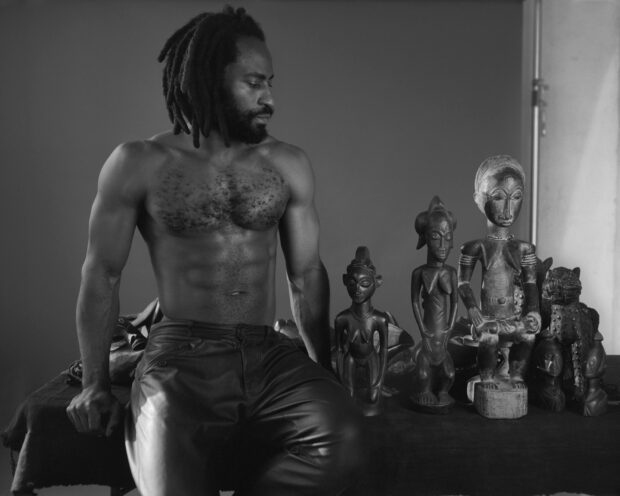
Bravo Giana! Intense observation.
I truly enjoy reading through on this site, it has got fantastic articles . “It is easy to be nice, even to an enemy – from lack of character.” by Dag Hammarskjld.
You actually make it seem so easy with your presentation but I find this matter to be actually something that I think
I would never understand. It seems too complicated and extremely broad for me.
I am looking forward for your next post, I will try to
get the hang of it!
Wow, fantasti blog format! How long have you ever been blogging for?
you made running a blog glance easy. Thhe entirre look of your site is
magnificent, as smartly as tthe content material!